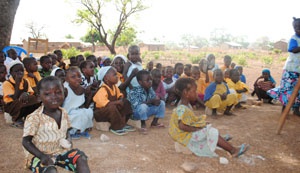The ruling National Democratic Congress (NDC) government’s purported achievement of drastically reducing schools under trees in the Northern region, which is currently a trump card for its campaign, has been challenged by residents.
Residents in areas visited by DAILY GUIDE including the Nanumba North and South districts said they could not fathom why their wards were still been tutored under uncompromising conditions when according to government, monies had been allocated for structures.
“Our children carry kitchen stools from the house to school and come home very dirty because they have no school building,” a worried resident said.
Some notable primary, junior and senior high schools in various Metropolitan, Municipal and Districts Assemblies (MMDAs) still operate under trees and thatch sheds.
The practice of pupils being taught under these poor structures, according to educationists, is believed to be one of the major threats to Millennium Development Goal 2.
It has also been reported that this challenge was the reason for the poor performance of students in the Basic Education Certificate Examination (BECE) in the last three years.
Within the Tamale metropolis alone, about 7 schools under trees were created in 2009 at the various suburbs, raising concerns about government’s pledge in ending the practice.
The NDC, soon after assuming office in 2009, promised a total overhaul of the educational sector including the construction of classroom blocks in various schools. The major focus was the elimination of schools under trees.
President John Dramani Mahama, then Vice President, reiterated government’s commitment to eliminate all schools under trees by 2012.
Investigations however conducted by DAILY GUIDE reveal that a number of these schools under trees are yet to have permanent sites for construction to commence.
One of such schools is the Sanzirigu Mujahada English Arabic Primary schools within the Tamale Metropolis which was started early 2009 without any structure.
Pupils of the school, numbering over 170, unlike their counterparts in other parts of the city, are currently using a dilapidated structure belonging to a private developer as their classroom. Pupils of the school sit on stones and other objects they can lay their hands on in order to enable them partake in the class session.
Despite its proximity to the main Tamale-Salaga highway and its associate dangers, pupils and teachers have no option but rely on the surrounding trees as their classrooms.
Another is the Roman Catholic Primary school at Tali in the Tolon/Kumbungu District of the Northern region with a population of 175 pupils.
Our checks also uncovered that the pupils of the school study under trees as a result of the collapse of their school building in September 2008.
The office of the head teacher of the school was located under a huge tree with his office equipment kept under the shade whilst the school clock was hanged on the tree and beneath it was the school bell. The school uses a room in the community as a store room for their teaching and learning materials.
The furniture being used are completely worn out due to their exposure to the sun and rains. The school has accused the community, and nearby villages of stealing some of the broken furniture for firewood and carpentry works. The only structure on the school compound is a urinal.
DAILY GUIDE also learnt that any sign of clouds in the sky, meant there must be a compulsory holiday for the school as the children and staff had no place to seek protection from the rains.
Teachers were reluctant to give details of the school to anybody unless the person was from the Ghana Education Service (GES) office.
This paper also discovered that first year students of the Wulensi Senior High School in the Nanumba South district of the Northern region were taught under trees due to the non-availability of classroom blocks.
Investigations reveal that four out of the six classes of the first year students have been merged into two due to the lack of classrooms, thereby reducing the number of classes to four.
“Our situation is very sad and we hope that things will improve very soon so that we can match up with our colleagues in other schools,” a student revealed.
When contacted, the headmaster of the school, Mr. Mahama Andani was not ready to comment on the matter except to say that the state of the first year students was a temporary one and that plans were far advanced to provide them with decent classrooms.
General News of Wednesday, 10 October 2012
Source: Daily Guide













